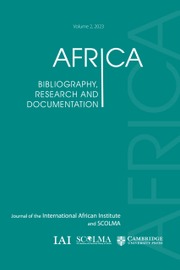From the earliest experiments in the 1940s and 1950s, the story of Anglophone African detective fiction has been … a narrative of writers establishing and extending the boundaries of the detective story to make it serve African realities …. African writers have been, and remain, endlessly innovative in domesticating the detective story for local, regional, and Africa-wide audiences …. African writers have, wittingly or not, turned the detective story into a highly productive mode of social and political critique. (185–6)
So Matthew Christensen summarizes his argument. A professor in the Department of Literature and Culture at the University of Texas, he obviously enjoyed his research, stating in his acknowledgements:
Writing this book has been a work of detection as much as it has felt at many times like piecing together the history of Anglophone detective fiction has involved no small effort of ferreting clues, identifying suspects and witnesses, weighing evidence and motivations and fitting together the pieces of a puzzle…. In the continued pleasure the writing has given me I have never felt anything less than that I was getting away with something. (ix)
This is an academic work with no shortage of jargon and specialist language of literary theory and socio-economics, but it also has much to interest those who, like this reviewer, enjoy a good whodunit for more relaxing reading. Christensen uses his survey of the genre to open up new ways of thinking about African societies, politics, economics and religion (including Pentecostal megachurches, prosperity gospels and Islamic extremism), showing that ‘seemingly escapist entertainments are performing critical cultural work in the transformation of African communities’ (184).
The introductory chapter gives a chronological starting point – the Ghanaian R. E. Obeng with a collection of stories about an African detective in 1942. Christiansen sketches out his main themes, defines his terms and explains his methodology and comparative approach. The classic English whodunit holds the implicit promise of legal justice. This just doesn’t apply in African contexts. African detective fiction opens up questions about law and the courts, notions of criminality, justice and the state, accountability of the rich and powerful. Christiansen asks whether African detective fiction is derivative or authentically African. He explores antecedents and influences: Conan Doyle, Edgar Allan Poe, Agatha Christie and the English Golden Age, Raymond Chandler, Hadley Chase and American pulp fiction.
The first chapter, ‘Dispossession, realism and the sovereign self in the colonial era detective story’, studies the writing of Cyprian Ekwensi (Nigeria) and Arthur Maimane (a South African writing in Drum) and their focus on labour, property and alienation, concluding ‘that their Africanization of an imported genre directly defied colonial legislation of racial and cultural purity – most fully realized in South Africa under apartheid governmentality – their detective fiction is much more radical than it has been given credit for’ (7). Not much more Black detective fiction was published in South Africa as the grip of the apartheid state tightened. Elsewhere in Africa, with independence came ‘a slow trickle of detective stories, novellas and newspaper serials in the 1960s’ (58). Then came a minor flood in the 1970s and 1980s with celebratory texts featuring ‘trustworthy honourable police [who] preserve the peace of fundamentally just societies or in which secret agents defend independent nation-states from neo-colonial conspirators’ (58).
Later chapters follow the genre through from the 1960s to the mid-1980s when police procedural and espionage thrillers predominate. Christiansen coins the term ‘neoliberal noir’ arguing that
given its historical engagement with the crises of liberalism and global capitalism, detective fiction offers an especially rich critical apparatus for investigating the morphing values of sociability, criminality and political legitimacy under these conditions of intensified social and epistemological recalibration …. The explosive growth of the crime mystery is partially a function of neoliberal publishing economics. But many writers embraced the detective story for its capacity to dissect the profound crises of selfhood, sovereignty and collective obligation wrought by political and economic neoliberalization. (117)
A chapter entitled ‘Seriality, stasis and the neo-liberal state’ showcases the influence of franchised novel series from 2000 onwards, with particular attention to the series of Kwei Quartey (Ghana) and Parker Bilal (the pen name of British/Sudanese writer Jamal Mahjoub, who set his stories in Cairo). This chapter also considers ideas of time and temporality, economics of publishing and global marketing and has an intriguing comparison of African crime fiction and Scandinavian noir. A final chapter, ‘Managed risk and the deadly allure of transparency’, focuses on Rozina Umelo (Nigeria) and Angela Makholwa (South Africa) and has some pertinent comments on the South African Truth and Reconciliation Commission, disclosure, transparency and the ‘neoliberal technology of the self’.
I would have appreciated more on African detective literature in French, Portuguese, Swahili and other African languages. Christiansen notes that there are ‘hundreds’ of novels in languages other than English although studies of them are unfortunately sparse. I would also have liked more on gender. Golden-age English detective fiction was dominated by female writers (Agatha Christie, Dorothy Sayers, Margery Allingham and others). There is treatment of Unity Dow, Adaora Lily Ulasi and a few others but the great majority of African writers in this genre are male.
The book includes an excellent ‘Anglophone African detective fiction bibliography, 1940–2023’. Modestly described as ‘partial’ and ‘work in progress’, it includes children’s stories, school readers and relevant serial publications (192–200). It is a gift to scholars and genre aficionados alike. I certainly made notes of titles and authors to pursue further. There is also a separate bibliography of critical work and a good index. Production values are high – I found no typos and appreciated footnotes not endnotes (a rare treat in scholarly publishing these days).


